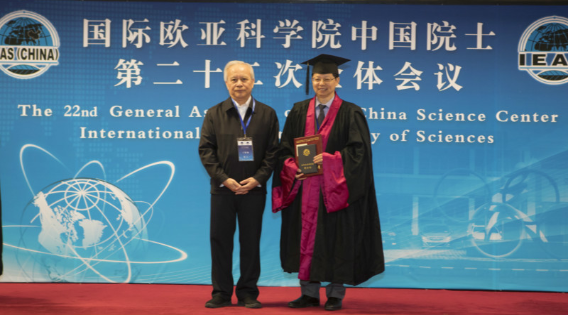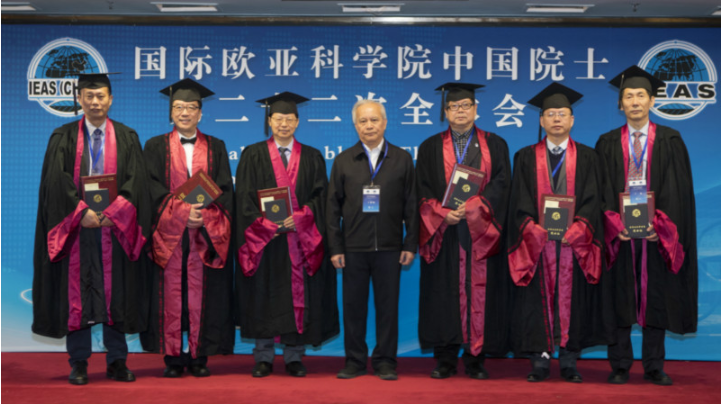On November 16, 2019, the 22nd General Assembly of the China Science Center, International Eurasian Academy of Sciences was held in Beijing. Professor Song Yongduan, dean of the School of Automation, Chongqing University, was among the 24 Chinese scholars elected as academicians of International Eurasian Academy of Sciences.

Academician Wang Qinmin, executive chairman of China Science Center of the International Eurasian Academy of Sciences, is issuing the certificate.

Academician Song Yongduan (third from left) and other academicians of the International Eurasian Academy of Sciences
On November 11, 2018, at the 21st General Assembly of the China Science Center, International Eurasian Academy of Sciences, a number of scholars with profound academic background were elected as academician candidates of the International Eurasian Academy of Sciences. According to the Constitution of the International Eurasian Academy of Sciences, the election was started in April 2018. The election process included preliminary evaluation, selection and nomination by the Election Committee, candidate defense, election by the Academician Presidium and selection of official candidates for academicians through voting of all academicians. The result was finally confirmed by the Headquarters of the International Eurasian Academy of Sciences.
The selection of Chinese scholars as academicians of the International Eurasian Academy of Sciences is a reflection of the international recognition of Chinese scientists. It also opens a new channel for improving the international reputation of Chinese scientists and expanding China’s influence in the international scientific and technological community.
The International Eurasia Academy of Sciences (IEAS), founded in 1994, is a well-known organization of scientists initiated and established by Academician Savin, a famous aerospace scientist (the chief designer of Mir Space Station and resident of Former Soviet Central Research Institute). At present, IEAS has more than 600 academicians and corresponding academicians from 46 countries including Europe, Asia, North America, South America and Australia.
The International Eurasian Academy of Sciences is headquartered in Moscow. At present, it has three regional centers respectively in Europe (Netherlands Czech Republic), Eurasia (Russia) and Asia Pacific (China), and has established scientific centers in 15 countries. The China Science Center of the International Eurasian Academy of Sciences, founded in 1996, is an important high-level scientific and technological organization in China and even in the world. It has made noticeable contributions to promoting international scientific and technological cooperation, and to the economic, ecological, cultural, social coordination and sustainable development of the Eurasian continent, and the independent management of scientists.
Since 1996, IEAS has elected the Chinese academician, the corresponding academician and the honorary member (including Hong Kong, Taiwan and foreign Chinese scientists).The selected academicians are well-known natural scientists, social scientists and management scientists at home and abroad. At present, the Chinese Science Center of the International Eurasian Academy of Sciences has 180 academicians in total. More than one third of the academicians are also academicians of the Chinese Academy of Sciences, the Chinese Academy of Engineering or other international scientific institutions and foreign academicians the National Academy of Sciences. Among them, there are many famous scientists with outstanding contributions and high prestige, heroes of "atomic and hydrogen bombs and man-made satellite", as well as scientists who have won the national highest honor award, "the Medal of the Republic" (Chen Fangyun, Liu Dongsheng, Sun Jiadong, etc.). They have made creative and systematic achievements in the process of scientific research and technological innovation, and made significant scientific, economic and social contributions.
